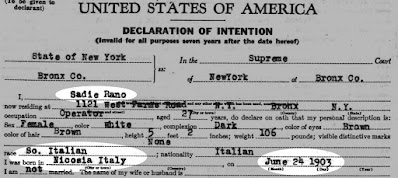I finally did it. I hired professional genealogists to do what I can't: find my ancestors' records in a church in Italy.
 |
| My ancestors' church |
For one full week I tried not to think about the two genealogists who were visiting the tiny hamlet where my ancestors lived.
And then came the results. Eleven high-resolution images of documents dating back to 1803. The images were numbered one to eleven, and a PDF file gave me a brief explanation of what they were.
Anxiously, I opened up my family tree and went to my grandmother's family. Her parents (last names Sarracino and Saviano) came from this little hamlet called Pastene. I've been there and visited the cemetery. I've viewed the town countless times on Google Earth. It's a long, thin string of houses and an old church. That's it.
Examining the Results
With my family tree on one monitor, I started going through the new images on another.
#1 The 1873 marriage record for Giovanni Saviano, the brother of my great great grandfather Antonio. I would have liked to learn the bride's mother's name, but this type of record includes no parents.
#2 The 1842 marriage record for Giovanni's and Antonio's parents, my 3rd great grandparents, Raffaele Saviano and Grazia Ucci. This confirms two facts for me:
- my great great grandfather Antonio was their first-born child
- my 3rd great grandmother's name was not Maria Grazia as I'd suspected, but Grazia.
#3 The 1864 marriage record for my great great grandparents Giuseppe Sarracino and Maria Luigia Muollo. One of my goals was to learn Maria Luigia's mother's name, but it is not there. It did tell me that my estimated birth year for one of their sons is almost certainly wrong.
Those are all great facts even though they don't provide what I really wanted: parents' names.
The rest of the documents had me puzzled. I wasn't quite sure who I was looking at. My family tree documents that Giuseppe Sarracino's (from document #3) father was Antonio. But was this him?
#4 The 1821 marriage record for Antonio Sarracino and Vincenza Perrella. Vincenza was from another town. Is he my Antonio?
#5 The 1826 marriage record for Antonio Sarracino and Anna Maria Muollo. Wait, what? I'm still not sure who's who.
#6 through #11 are records of households in the town. The church wrote these lists of the "souls" in their town, but to a genealogist, they're basically a census. OK, here we go.
1803: A husband and wife and their deceased parent's names. They have one son named Antonio Sarracino, age 4. So far, technically, this could be my 3rd great grandfather Antonio Sarracino. He's about the right age. But that's not proof.
 |
| 1803 church record for Domenico Sarracino's household |
1816: The same family with two more daughters.
1823: The same family, but now the mother has died, and Antonio's wife from document #4, Vincenza Perrella, has also died.
1827: Now Antonio no longer has his sisters with him. He has his father, the widower, and his new wife, Anna Maria Muollo from doument #5. They have a new baby named Teresa.
 |
| 1827 church record for Domenico Sarracino's household |
1833: The same family members plus two more children for Antonio and Anna Maria: Giovanni and Mariagrazia.
You know, I'm still not sure exactly what I've got here!
The last document. 1837: Antonio has a household of six people now. His father is not there and may have died. His children are all still alive. Teresa. Giovanni. Mariagrazia. And a new baby: Giuseppe Sarracino.
 |
| 1837 church record for Antonio Sarracino's household. The youngest baby is my great great grandfather. |
That's it! This is in fact the family of my great great grandfather Giuseppe Sarracino. Back up a minute. Now that I know who this family is, let's take a closer look at all the details.
From these six household lists, I've learned the names of:
- My great great grandfather Giuseppe's three older siblings.
- His mother's name and her parent's names. Those are my 4th great grandparents Francesco Saverio Muollo and Grazia Cimino.
- His father's parents' names: Domenico Sarracino and Teresa Mastroberardino. They're also my 4th great grandparents.
- Domenico and Teresa's parents' names. Those are my 5th great grandparents: Giovanni Sarracino, Rosaria Santangelo, Domenico Mastroberardino and Maria Tufo.
What an incredible revelation! The lack of civil documents for this town had me stuck. But these simple lists found in the church records brought me back three generations. This is something I can't imagine doing on my own. In this remote little town, my broken Italian wouldn't get me very far.
Now I am absolutely planning to go into that church on my upcoming visit to Italy. Simply standing there, knowing the names of many generations of my ancestors who were baptized and married there, will move me to tears.
So what's next? My researchers tell me there is a central church archive that may help me with my Saviano branch.
In the meantime, I have the names and ages of two new great aunts and a great uncle. There's a good chance that inside the Pastene records I've downloaded to my computer I will find their children. The records for those children may tell me more about their mother's Muollo ancestors.
The quest continues!















